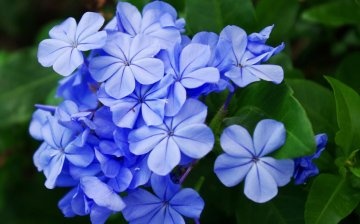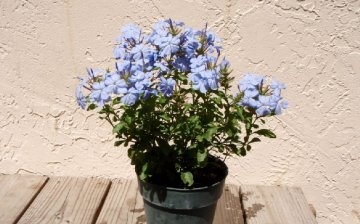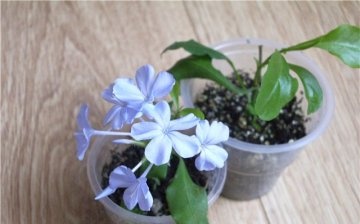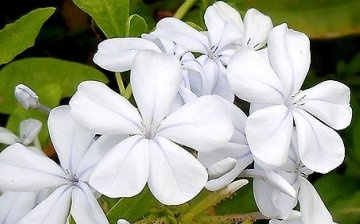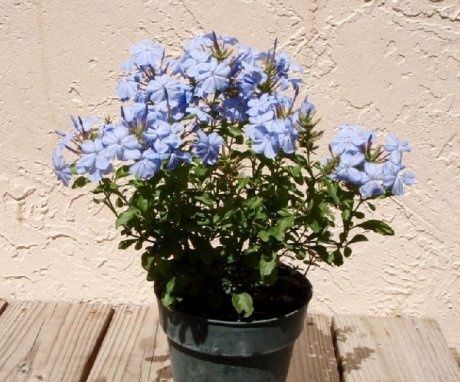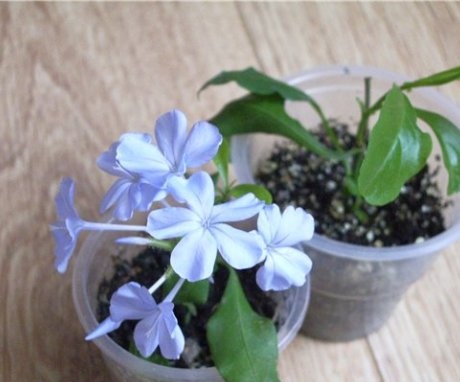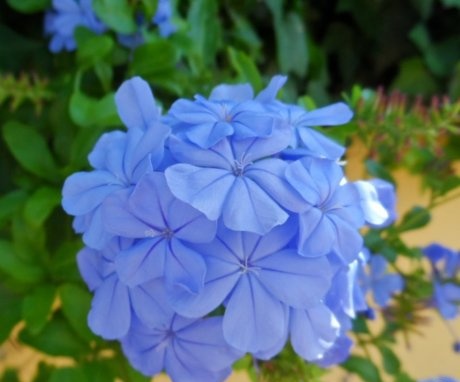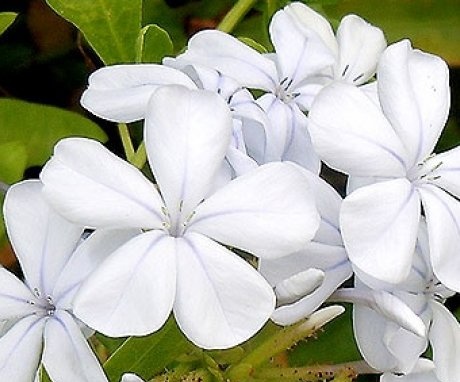Plumbago is a beautiful plant for home and garden
A lush and touching plant called plumbago adorns not only premises, greenhouses and conservatories, but also household plots. It is quite unpretentious, blooms beautifully and does not require special conditions. With the help of this ornamental plant, trunks are formed, let it go along trellises or along a wire in the form of a spiral. It turns out to be a very beautiful and unusual sight. About the features agrotechnics, care, reproduction and crown formation will be discussed in this horticultural reference.
Content:
Description of plumbago
In the wild, plumbago or pigweed grows in tropical and subtropical regions. Features of the structure:
- It is a perennial in the form of a shrub or semi-shrub, reaching a height of three or more meters.
- The stems of the plant are weakly bending, they do not have whiskers and thorns.
- The leaves are simple, whole. They are located on the stem in a spiral.
- Flowers are collected in clusters at the crown of the shoots. The color of the inflorescences varies - white, blue, red, pink.
In the countries of Asia and Africa, plumbago is used as a medicine. It is considered an excellent antiseptic. The culture is widely used in landscape design and interior decoration. C
branches are often grown in flowerpots or tubs, which are taken out into the open air in the summer, thus decorating the entrances to verandas, terraces or gazebos. From plumbago, you can form a standard tree that will decorate a room or balcony. At home and in flowerpots in the fresh air, only one type of plumbago is grown - the ear-shaped pig.
Growing conditions
The plant prefers light rooms. It should be kept in a room exposed to scattered sunlight. But it is not recommended to put a flower on a windowsill on the south side. Direct sunlight falling through glass can burn foliage. In the summer, it is advisable to take the plumbago out into fresh air, in a sunny place. Dark rooms are not suitable for lead.
The pig is a rather unpretentious plant, but it also has certain requirements for the microclimate and soil.
The soil mixture for the plant is selected slightly acidic and consisting of sod, leafy soil, humus, peat and sand. The ratio of parts is 2: 1: 1: 1: 1. The culture tolerates drought well, but it treats waterlogging badly. If the soil is waterlogged at low temperatures, root system plumbago will rot.
The air temperature when the plant is kept in the summer is 18 ° -22 ° C. In the period from October to February, the flower is removed to a cool place with an air temperature of no higher than 10 ° C. If you do not follow this condition, the lush vegetation of the plumbago will crumble, and you may not wait at all for flowering. Temperature regime is, perhaps, the only strict requirement for the content of culture.
Reproduction methods
Plumbago breeds cuttings or seeds... Florists prefer the first method, since after the rooting of the cuttings, flowering occurs within 3-4 months. If the plant is propagated by seeds, it will come only after six months or even later.
Sowing seeds:
- Seeds are sown in spring in a soil mixture consisting of peat and sand.
- Before planting, the soil is moistened, the boxes are placed in a warm, bright room with an air temperature of 20 ° -22 ° C.
- It usually takes two weeks for the seeds to germinate.
- Then seedlings dive in small containers.
- As the roots develop, plumbago is transplanted into large containers.
Gardeners prefer the method cuttings:
- Cuttings are cut from the upper shoots and placed in a mixture of sand and leafy earth in equal proportions.
- Rooting takes approximately two to three weeks.
- After the seedlings are transplanted into small containers with soil from turf, leafy soil, humus, peat and sand.
Flowering can come in as little as three months. The main requirement germinating seeds or cuttings - this is a temperature regime, 20 ° -22 ° C, moderately moist soil and light.
Care rules
Pig is an unpretentious plant and does not require special care:
- Watering carried out as the topsoil dries out. In summer, plumbago is often watered, in winter - very rarely. Sprinkling is necessary only in case of an elevated air temperature, more than 25 ° C.
- The plant has a positive attitude towards fertilization. Top dressing is carried out twice a month in summer and is stopped in winter. Make a full range mineral fertilizers according to the instructions on the package.
- The main point of care in the first three years of growth is considered transfer... The plant grows rapidly and is transplanted every year into a larger container. After three years of life, plumbago can be transplanted once every 2-3 years.
- The formation of the plant is done in early spring. Cut off old shoots so that the bush is lush and beautiful in the future. Lead stems are tied to a support, which can be of very different shapes - in the form of a cone, circle or arch. Plumbago is often formed into a stem. To do this, the main stem is tied to a vertical column, and the side shoots are cut off. This is how a lush crown is formed, covered with caps of blue flowers.
The rest of the plant is not demanding and develops well without additional efforts on the part of the grower.
Diseases and pests
The most frequent guests on the mite are the spider mite and the scale insect. Less commonly, the plant is attacked by worms. Control measures are reduced to manual pest removal and insecticide treatment of the crop. The scabbards must be removed from the bush, otherwise the use of chemicals will be useless. Insects have a protective shell. They are removed with a cotton pad dipped in alcohol.
Of the diseases, only root rot can be distinguished. Its appearance signals waterlogging of the soil. To save the plant requires transfer and removal of the affected areas of the root system. Be careful when watering the plumbago. The rule works here - it is better to underfill than to overfill. Lead copes with drought with ease, but not with dampness.
If you follow those few rules of care and maintenance, plumbago will not hurt.
It will delight the owner with lush flowering and greenery. Shape the culture into different shapes with supports. So the room or garden will instantly transform, the plumbago will decorate even the most ordinary-looking corner with touching flower tassels!
More information can be found in the video:



